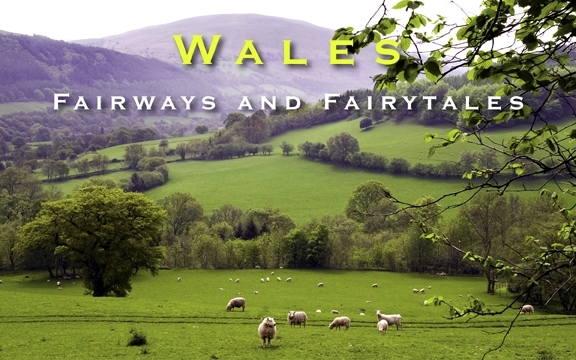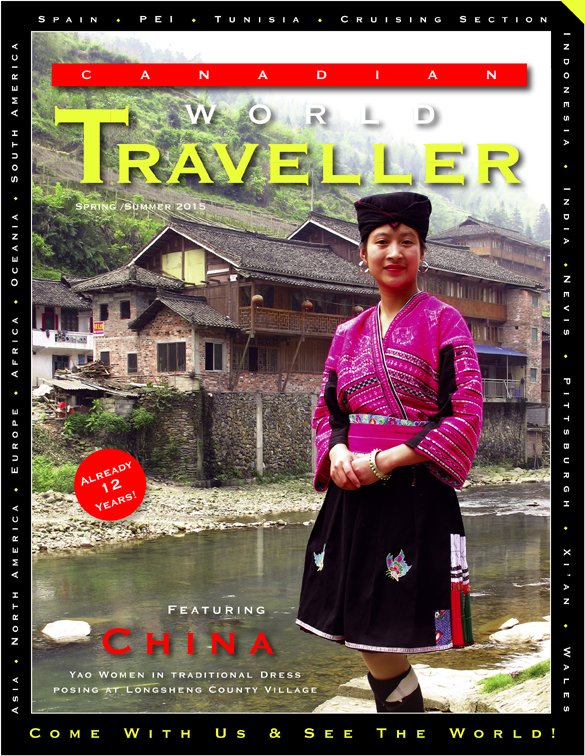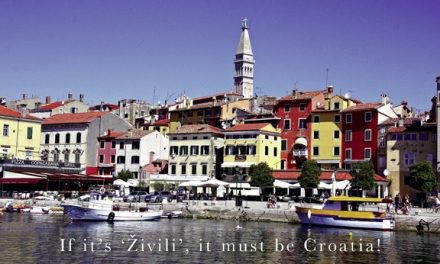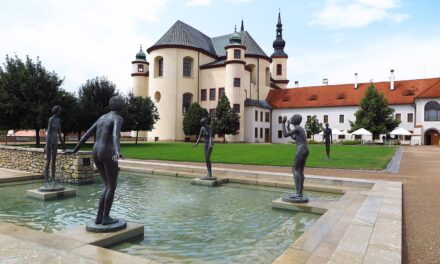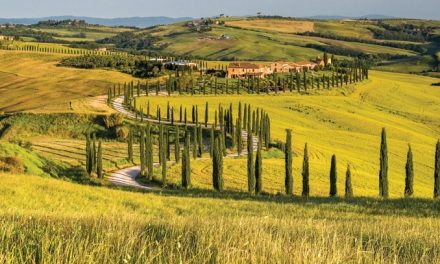Wales
Fairways and Fairytales
Article & Images by Cherie DeLory

I could hardly believe my good fortune while on a golf road trip in the undulating Usk Valley, in Newport, South Wales. I was about to play my first ever 18-hole course. But this was not just any course. I adjusted my golf cap and made my way out of the five-star Celtic Manor Resort clubhouse to head towards the fairway of what was to be, in mere months, The Twenty Ten Ryder Cup championship course, hosting the greatest players in golf from around the world.
In a country where medieval castles, fortresses and stone ruins harmoniously christen the dramatic Welsh landscape, it was apparent that fairytales do come true. My eyes wandered to a derelict stone farmhouse adjacent to the posh clubhouse. I wasn’t sure which structure looked more out of place amongst the picture-perfect frost-laden Welsh hills and valleys. At least the sheep would have a place to hide from my wayward shots, I thought.
The Celtic Manor Resort boasts three world-class courses, a swank clubhouse, Golf Academy, beautifully appointed accommodation, restaurants and bars humming with live entertainment, spa, and boutique shops. I took a golf lesson to tweak my left handed swing, purchased my first pair of snazzy golf shoes, and kicked back in the lounge with a Welsh libation and discussed how I could improve my game in the days to come.
Land of Castles
Wales is recognized as a world-class golf destination, with at least 200 courses. And with over 500 castles, the “castle capital of Europe” is certainly one of the most romantic places for tee time. I visited the Rolls of Monmouth Golf Club. This championship course, set on the sprawling estate of automobile tycoon and aviator Charles Stuart Rolls, raises golf to a regal level. The 18th century mansion hosts weddings and private functions. And where the co-founder of Rolls Royce once tinkered in his workshop and garage, is now home to the Rolls of Monmouth clubhouse. Overnight accommodation in an intimate setting is available in one of three cottages located on the property.
Before visiting the Rolls of Monmouth, I briefly visited the market town of Chepstow and toured the walled town and castle, a short two hour drive from London. Chepstow Castle is the oldest post-Norman castle in Britain. Its remarkable ruins sit atop limestone cliffs overlooking the River Wye, which forms the border between England and Wales. Nearby Tintern Abbey, in the village of Tintern, is a glorious 12th century stone monastery set amidst the greenery of the countryside, with sweeping ornate arching windows and doorways. The gothic ruins are the best preserved monastery in Britain and its beauty has inspired poems and paintings by the likes of William Wordsworth, Dylan Thomas and J.M.W. Turner. Be sure to stop by the Old Station Tea Room Cafe at Old Station Tintern. The Victorian tea room, tucked in the heritage railway waiting room, has won several tourism awards for best place to eat in Wales.
I stayed overnight at the St. Pierre Marriott Hotel & Country Club in Chepstow, an elegant 14th century stone manor with wood-burning fireplaces, two championship golf courses, heated pool and spa. An 11th century stone church sits on the property as well, making for an endearing romantic setting.
Wales Coast Path
The next day another round of golf was on the schedule at Southerndown Golf Club. I had a hearty breakfast of fruit, eggs and sausage, and my first Welsh cake (similar to a tea biscuit). On the way, we headed to the coast and the seaside village of Ogmore-by-Sea. Here you can begin a hike along the Glamorgan Heritage Coast walk, part of the newly opened Wales Coast Path. This stretch of undeveloped natural coastline runs 1,400 km from Chepstow to Queensferry. Wales is the only country in the world where you can walk the entire coast from end to end. The Path is accessible from several towns, and some sections are bicycle friendly.
The only mileage I accumulated on this day was on the greens at Southerndown Golf Club. This rugged championship course is well liked in the golfing world, rated in the top 13 among Wales. The property overlooks the coast, and the town of Porthcawl, and it’s not uncommon to see sheep grazing a chip shot away in the craggy heathland.
A Slice of Welsh Rarebit
My night’s accommodation and dinner was at the Great House, an elegantly restored heritage stone hotel located in Bridgend, a stone’s throw drive from Porthcawl. I was intrigued to try the Welsh rarebit, convinced it was a rare variety of rabbit meat. Boy was I wrong. For the uninitiated, it’s a modest comfort food dish of melted cheese infused with paprika and ale on a slice of toast. What’s not to like?
The culinary and spirits scene in Wales is thriving. I pursed my lips and held my breath while sipping back the award winning Single Malt Welsh Whiskey at Penderyn Distillery, located in Brecon Beacons National Park. The sole distillery in Wales has been distilling whiskey for over 100 years. Visitors are shown guided tours of the distilling process and the history of whiskey production in Wales. In the tasting room you can sample more award winners, namely the Brecon Five Vodka, Brecon Gin, and, my favourite, Merlyn Cream Liqueur.
Cheddar in a Coal Mine
For a taste of the wild, I foraged for mushrooms in St. Pierre Woods and nibbled on homemade Welsh cheese at the Blaenafon Cheddar Company. Their Pwll Mawr cheddar is matured in the Big Pit coal mine, a decommissioned coal mine in the world heritage village of Blaenavon. It’s now the National Coal Museum and visitors can descend 90 meters into the mine with a former miner. Coal mining was a major industry in Wales, with the seaside town of Barry in the Vale of Glamorgan clocking in as the top coal exporting port in the world, followed by the port in the capital city of Cardiff in the early 1900s.
I visited the nearby market town of Abergavenny to explore the Abergavenny Market Hall for local lamb, cheese and dairy, chocolate and produce. Fragrant canary yellow daffodils, the Welsh national flower, are in abundant supply, and remind me that spring has sprung. I’m also told about Britain’s foodie event of the year, the Abergavenny Food Festival. This year it’s the weekend of September 19-20. The biggest and oldest food festival in Wales is Britain’s best kept secret. It brings together the greatest chefs, farmers and fishermen in a celebration of food and drink.
It wasn’t long before the inspiring countryside was a distant memory and I arrived in Cardiff. I drove past The Roahld Dahl Plass, a vibrant outdoor space in the Cardiff Bay. The assuming copper amphitheatre is a nod to Cardiff-born Roahld Dahl, famous children’s author lauded for classics such as “Charlie and the Chocolate Factory” and “Esio Trot”, which was recently adapted to the screen in a made for BBC television film starring Judy Dench and Dustin Hoffman. Other upcoming city highlights included dinner at the majestic Cardiff Castle, and a visit to the National Museum.
The Welsh Way of Life
My destination for the afternoon was St. Fagans National History Museum where I was invited to escape back in time. The museum is located on the 100-acre grounds of St. Fagans Castle and gardens, a late 16th century manor house (open for tours) donated to Wales by the Earl of Plymouth. Also on the property is an open-air museum, which recreates buildings from different historical periods and illustrates the Welsh way of life and traditions. In the mock village you can visit a schoolhouse and perhaps test your knowledge of the Welsh language. Wales may be the smallest country in Great Britain, but what it lacks in geographical size it makes up for in word size. Welsh is the oldest language in Great Britain and it’s not unusual to trip over the pronunciation of a word due to its length, and structure of the vowels. If you can say Llanfairpwllgwyngyllgogerychwyrndrobwllllantysiliogogogoch correctly, you’ve successfully pronounced the longest place name in Europe. It’s a village on the island of Anglesey, in North Wales. Prince William and the Duchess of Cornwall lived on the island for a time after they married.
The Welsh village also has a general store, woollen mill, bakehouse, blacksmith, photography studio, and farmyard. Don’t miss the 1920s-style tearoom to savour freshly made Welsh cakes, and a spot of tea. This is Great Britain, after all.
Visitwales.com
Click on cover to view published article

